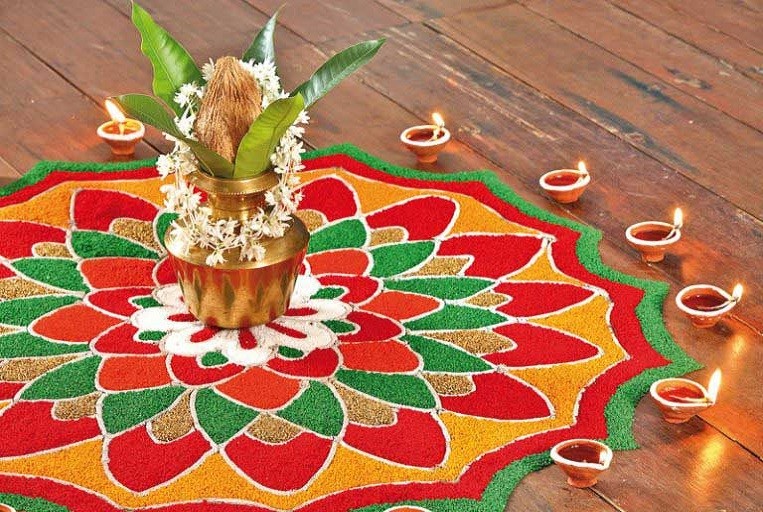Festive seasons in Sri Lanka
Sri Lankans are known for the love of holidays – and there is always a guarantee of one holiday every month – a full moon Poya day; significant to Buddhists and hence declared a public holiday. Because the island owns a mixture of religions and ethnicities, every holiday brings a feeling of excitement for everyone, and of course a better understanding of the different religions, culture and traditions.
Deepavali
The Hindu festival of lights is in celebration of Lord Rama’s return to Ayodhya – after defeating Ravana, and Lord Krishna’s win over the Narakasura demon. The overall theme of these sagas is that the good will always triumph over evil and hence light is a symbol of diminishing the darkness.
Preparations of this festival usually begin five days prior – with the cleaning of homes. The night of the festival coincides with the night that has the darkest new moon – providing an ideal backdrop for the bright glow coming from thousands of clay lamps lit in homes and temples.
Devotees visit Temples dressed in new clothes to offer Pooja to Goddess Lakhsmi – the God of fertility and prosperity. They then indulge in the compulsory tradition of milk and ghee based sweet eats.
Sowing Season
Begins on Vap Poya day in the month of October – lasting for a month, and ends on Il poya day that comes in November (which also coincides with the end of the Southwest monsoon). The sowing season is also known as the Katina period where devotees put together new robes for the monks and gift these to the Temple during Pooja.
Beating drums, talented dancers and a few elephants gather together at about 4.00am to carry these robes in a procession to the nearby temple. This was a traditional ritual performed by ancient royalty in Sri Lanka.
Oh, and it is interesting to note that it was on the day of Il Poya that the foundation for the first ever Buddhist stupa in ancient Anuradhapura was laid. Furthermore, according to the legends, it was during this season that Lord Buddha’s chief disciple was appointed and the next heir to the throne was enlightened and entered the order with a 500-strong retinue.
Christmas
Whether you are entering a commercial environment or a Christian home, Christmas preparations begin as soon as the month of December arrives. Celebrating the birth of Jesus Christ, notice how streets and hotels across the island create wondrous sights with Christmas carols humming in the atmosphere.
Within homes, adults, children and even pets are cleaned and groomed for the festival. Christmas trees are put up in homes and streets and decorated with baubles, streamers and lights as Christmas gets closer. The delectable fragrance of the unique Sri Lankan Christmas cake and other tasty treats is everywhere!
When Christmas Eve arrives, everything is a whirl. Streets are packed with people completing their last minute shopping list and gifts for loved ones, yet they somehow find time for church in between. It is not just the Christians but the entire nation joins in the celebrations. Christmas is a season where the nation unites to enjoy a religious holiday centered around love, laughter, joy, hope, peace and sharing!
Eid-ul-Fitr
One of the most significant celebrations for the Muslims in Sri Lanka (and across the world) is the Eid that marks the end of the fasting month of Ramadan. It is celebrated on the 1st day of the 10th month of the Lunar calendar (and does not coincide with the Gregorian calendar hence the English dates vary). As Eid approaches, Muslims are out shopping for new clothes, gifts for their loved ones and groceries for preparing scrumptious meals.
Eid festivities last for about a week or so – where people dress up in new clothes, ladies apply henna on their hands, and families go visiting homes of their relations, exchange food and gifts of cash and kind. Some particularly popular food that is prepared during Eid are – different types of Biryani, Watalappam and Sheer Kurma. Dates are a popular fruit throughout the month of Ramadan and during the Eid Festival.
Wesak
Another very important Buddhist festival celebrating the birth, enlightenment and death of Lord Buddha is Wesak – the Buddhist festival of lights. Wesak is celebrated on the Poya day in the month of May every year. The exterior of every Buddhist home is decorated with skilfully crafted wesak lanterns in various colors. The streets are also lightened up with these lanterns and Pandols (telling stories of ancient Buddhism). Many families put up stalls on the road known as Wesak Dansals – where free food, drinks and ice cream is distributed to the public. These lanterns and pandols are exhibited on the streets for about a week. During peak wesak season, families gather in trucks, three wheelers, vans and by foot to explore the beautiful lanterns, visit a Dansal and enjoy a fun-filled night out.

